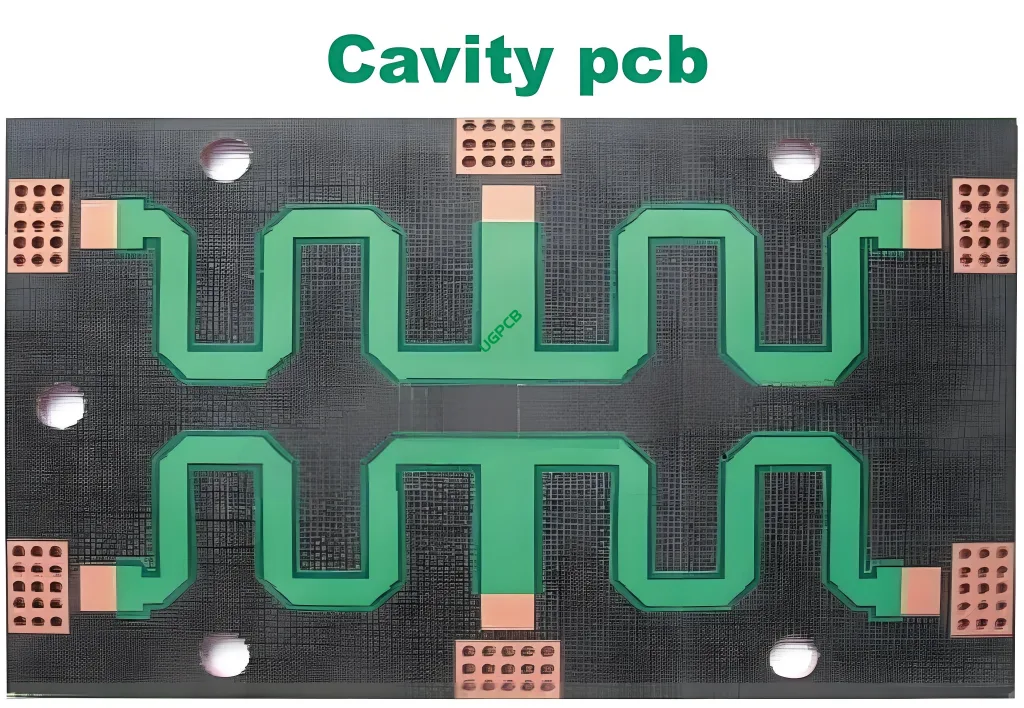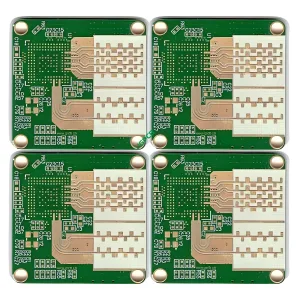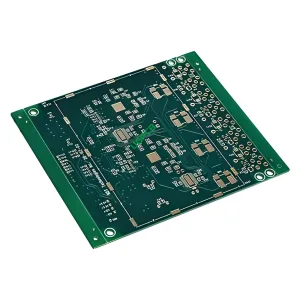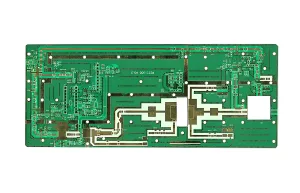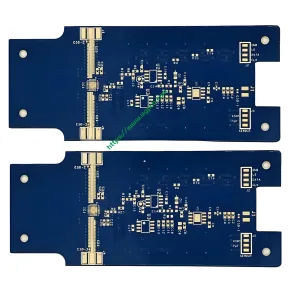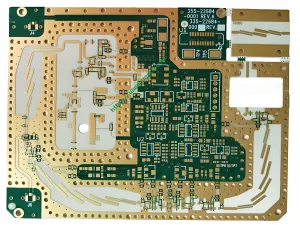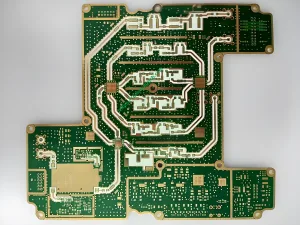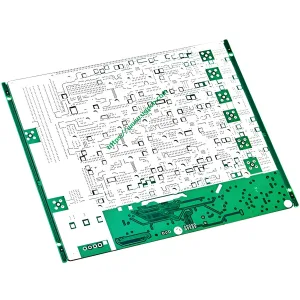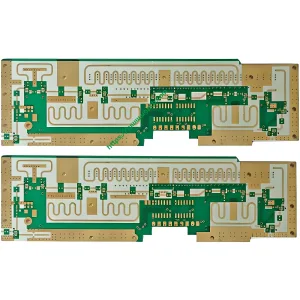ภาพรวมของโพรง PCB
โพรง PCB, แผงวงจรพิมพ์พิเศษ (พีซีบี), ได้รับการออกแบบมาเพื่อตอบสนองความต้องการที่เข้มงวดของแอพพลิเคชั่นความถี่สูงและไมโครเวฟ. การใช้ Teflon F4MB เป็นวัสดุหลัก, ผลิตภัณฑ์นี้ยึดติดกับคลาส IPC6012 2 มาตรฐานคุณภาพ, สร้างความมั่นใจในประสิทธิภาพและความทนทานที่เชื่อถือได้.
คำจำกัดความและข้อกำหนดที่สำคัญ
โพรง PCB นั้นโดดเด่นด้วยโครงสร้างโพรงที่เป็นเอกลักษณ์, ซึ่งสร้างขึ้นโดยการลบส่วนของวัสดุอิเล็กทริกเพื่อสร้างพื้นที่โพรง. การออกแบบนี้มีความสำคัญสำหรับแอพพลิเคชั่นเฉพาะเช่นตัวแบ่งพลังงาน, ในกรณีที่จำเป็นต้องมีการควบคุมการกระจายสัญญาณที่แม่นยำ. ค่าคงที่ไดอิเล็กทริกของ Teflon F4MB คือ 2.55, ให้การส่งสัญญาณที่มั่นคง. คุณสมบัติของบอร์ด 2 ชั้น, ด้วยความหนารวม 1.5 มม.. ความหนาของทองแดงถูกระบุที่ฐาน 0.5oz และความหนาสำเร็จรูป 1oz, สร้างความมั่นใจในการนำไฟฟ้าที่มีประสิทธิภาพ. เทคโนโลยีพื้นผิวที่ใช้คือการแช่เงิน, ซึ่งมีความสามารถในการบัดกรีและความน่าเชื่อถือที่ยอดเยี่ยม.
ข้อควรพิจารณาในการออกแบบ
เมื่อออกแบบโพรง PCB, ต้องคำนึงถึงปัจจัยหลายประการ:
- มิติโพรง: ควรกำหนดขนาดและรูปร่างของโพรงอย่างแม่นยำเพื่อให้ตรงกับข้อกำหนดของแอปพลิเคชัน.
- วัสดุอิเล็กทริก: Teflon F4MB ได้รับเลือกสำหรับค่าคงที่ไดอิเล็กตริกต่ำและการสูญเสียแทนเจนต์, ทำให้เหมาะสำหรับสัญญาณความถี่สูง.
- ความหนาของทองแดง: ความหนาของทองแดงที่เพียงพอเป็นสิ่งจำเป็นสำหรับการรักษาความสมบูรณ์ของสัญญาณและลดการสูญเสีย.
- พื้นผิวเสร็จสิ้น: การแช่เงินให้พื้นผิวที่ราบรื่นและเป็นสื่อกระแสไฟฟ้าสำหรับการแนบส่วนประกอบ.
หลักการทำงาน
โพรง PCB ทำงานตามหลักการของอิมพีแดนซ์ควบคุมและการสูญเสียสัญญาณน้อยที่สุด. โครงสร้างโพรงช่วยให้สามารถควบคุมการกำหนดเส้นทางสัญญาณได้อย่างแม่นยำ, ลดสัญญาณรบกวนและปรับปรุงประสิทธิภาพโดยรวม. วัสดุ Teflon F4MB ทำให้มั่นใจได้ว่าสัญญาณจะรักษาความสมบูรณ์ของพวกเขาเมื่อพวกเขาผ่านบอร์ด, ส่งผลให้มีประสิทธิภาพและเชื่อถือได้.
การใช้งาน
โพรง PCB นั้นเหมาะอย่างยิ่งสำหรับแอปพลิเคชันที่ต้องการการกระจายสัญญาณที่แม่นยำ, เช่นตัวแบ่งพลังงานในระบบการสื่อสาร. พวกเขายังใช้ในระบบเรดาร์, การสื่อสารผ่านดาวเทียม, และอุปกรณ์อิเล็กทรอนิกส์ความถี่สูงอื่น ๆ ที่ความบริสุทธิ์ของสัญญาณและความน่าเชื่อถือเป็นสิ่งสำคัญยิ่ง.
การจำแนกประเภท
โพรง PCB สามารถจำแนกได้ตามจำนวนเลเยอร์ของพวกเขา, การกำหนดค่าโพรง, และแอปพลิเคชันเฉพาะ. การจำแนกประเภททั่วไป ได้แก่:
- บอร์ดชั้นเดียวและหลายชั้น: ขึ้นอยู่กับความซับซ้อนของวงจร.
- ผอมมาตรฐานและแบบกำหนดเอง: ขึ้นอยู่กับข้อกำหนดเฉพาะของแอปพลิเคชัน.
- บอร์ดเฉพาะความถี่สูง: ออกแบบมาสำหรับแอปพลิเคชันความถี่สูงโดยเฉพาะ, มักจะมีวัสดุที่เข้มงวดและมาตรฐานการผลิต.
คุณสมบัติของวัสดุ
คุณสมบัติสำคัญของ Teflon F4MB, วัสดุที่ใช้ในโพรง PCB, รวม:
- ค่าคงที่ไดอิเล็กตริกต่ำ: ทำให้มั่นใจได้ว่าการหน่วงเวลาและการสูญเสียของสัญญาณน้อยที่สุด.
- ประสิทธิภาพที่มั่นคงในช่วงอุณหภูมิ: รักษาประสิทธิภาพที่สอดคล้องกันในสภาพแวดล้อมที่แตกต่างกัน.
- ความต้านทานสูงต่อการดูดซับความชื้น: ป้องกันการสลายตัวของคุณภาพสัญญาณเนื่องจากความชื้นเข้า.
กระบวนการผลิต
การผลิต PCBs โพรงเกี่ยวข้องกับหลายขั้นตอน:
- การเลือกวัสดุ: การเลือก Teflon F4MB สำหรับคุณสมบัติอิเล็กทริก.
- การออกแบบวงจร: การสร้างเค้าโครงวงจรโดยคำนึงถึงโครงสร้างโพรง.
- การแกะสลัก: ลบทองแดงที่ไม่จำเป็นเพื่อสร้างรูปแบบวงจรที่ต้องการ.
- การก่อตัวของโพรง: การตัดเฉือนที่แม่นยำเพื่อสร้างโพรงในวัสดุอิเล็กทริก.
- การเคลือบ: เชื่อมหลายชั้นเข้าด้วยกันภายใต้ความดันและอุณหภูมิสูง.
- การตกแต่งพื้นผิว: ใช้เงินแช่เพื่อเพิ่มความสามารถในการบัดกรี.
- การทดสอบและการควบคุมคุณภาพ: สร้างความมั่นใจว่าผลิตภัณฑ์ขั้นสุดท้ายเป็นไปตามข้อกำหนดและมาตรฐานทั้งหมด.
ใช้สถานการณ์
โพรง PCB ถูกใช้ในสถานการณ์ที่การกระจายสัญญาณที่แม่นยำเป็นสิ่งสำคัญ, เช่น:
- ตัวแบ่งพลังงาน: สร้างความมั่นใจในการกระจายสัญญาณในระบบการสื่อสารที่เท่าเทียมกัน.
- ระบบเรดาร์: ให้ความสามารถในการประมวลผลสัญญาณที่แม่นยำและมั่นคง.
- การสื่อสารผ่านดาวเทียม: เปิดใช้งานการถ่ายโอนข้อมูลที่เชื่อถือได้ระหว่างโลกและอวกาศ.
โดยสรุป, โพรง PCB เป็นแผงวงจรเฉพาะที่ออกแบบมาสำหรับแอพพลิเคชั่นความถี่สูงและไมโครเวฟ. โครงสร้างโพรงที่เป็นเอกลักษณ์ของพวกเขา, รวมกับคุณสมบัติของ Teflon F4MB, ทำให้เหมาะสำหรับการใช้งานในตัวแบ่งพลังงานและแอพพลิเคชั่นการกระจายสัญญาณที่แม่นยำอื่น ๆ.
 โลโก้ UGPCB
โลโก้ UGPCB

